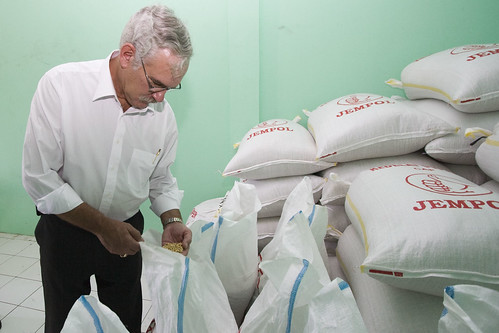
Acting Under Secretary for Farm and Foreign Agricultural Services Michael Scuse takes a handful of U.S. soybeans used at a ‘tempeh/tofu village’ production site in East Jakarta on April 6. Scuse visited the village – which uses 100 percent U.S. soybeans to produce tempeh and tofu, which are soy-based stables of the Indonesian diet – during an Agribusiness Trade and Investment Mission to Indonesia that he led last week. Photographer, Danumurthi Mahendra, U.S. Embassy, Jakarta
This is the third in a series of three blogs affiliated with USDA’s Agribusiness Trade and Investment Mission, which was led by Acting Under Secretary for Farm and Foreign Agricultural Services Michael Scuse.
While leading this week’s Agribusiness Trade and Investment Mission to Indonesia, I’ve been gratified to see firsthand how U.S. food and agricultural products are benefitting the Indonesian people. My itinerary included a visit to a tempeh and tofu production compound, or village, in the Cipayung neighborhood of East Jakarta, where local workers are using U.S. soybeans to produce nutritious, affordable, high-quality food products.
Tempeh, a cake made from fermented soybeans, and tofu or soybean curd, are staples of the Indonesian diet. Those with limited incomes rely on these relatively inexpensive, soy-based products for their high protein and nutrient content. Demand for the products continues to grow, especially in Greater Jakarta, which has one of the fastest-growing population rates of any urban area in the world. But historically, tempeh and tofu production has been small-scale, informal and often unhygienic.
In January 2008, the American Soybean Association-International Marketing (ASA-IM) – which receives export market development funding from USDA’s Foreign Agricultural Service – established Forum Tempeh Indonesia (FTI) to provide support to small-scale tempeh producers at the village level, particularly in the area of proper hygiene. Mercy Corps International, a U.S.-based humanitarian organization, has partnered with FTI to renovate tempeh and tofu production facilities in Jakarta under a pilot project. Supported by technical assistance through ASA, as well as private-sector funding, FTI and Mercy Corps have upgraded tempeh village facilities, hygiene practices and production equipment. As a result, production costs at these project sites have been reduced by as much as 30 percent.
Despite Indonesia’s growing demand for soybeans, the country’s domestic production is relatively limited. In fact, more than 60 percent of the soybeans consumed in Indonesia come from the United States. U.S. soybean sales to Indonesia have grown 40 percent in the last six years, reaching a record $805 million in calendar year 2010 and making it our fifth-largest market. All of the soybeans used at the Cipayung tempeh village come from the United States.
On my visit, I watched each step in the production process, and couldn’t help but feel pride in that U.S. support has helped to improve production of a food source important to Indonesians, and that U.S. soybeans are playing such a crucial role in feeding the Indonesian people and the world.
To learn more about the Agribusiness Trade and Investment Mission to Indonesia, visit our website.


















